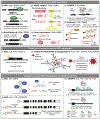Disruption of RNA Metabolism in Neurological Diseases and Emerging Therapeutic Interventions
- PMID: 30998900
- PMCID: PMC6545120
- DOI: 10.1016/j.neuron.2019.03.014
Disruption of RNA Metabolism in Neurological Diseases and Emerging Therapeutic Interventions
Abstract
RNA binding proteins are critical to the maintenance of the transcriptome via controlled regulation of RNA processing and transport. Alterations of these proteins impact multiple steps of the RNA life cycle resulting in various molecular phenotypes such as aberrant RNA splicing, transport, and stability. Disruption of RNA binding proteins and widespread RNA processing defects are increasingly recognized as critical determinants of neurological diseases. Here, we describe distinct mechanisms by which the homeostasis of RNA binding proteins is compromised in neurological disorders through their reduced expression level, increased propensity to aggregate or sequestration by abnormal RNAs. These mechanisms all converge toward altered neuronal function highlighting the susceptibility of neurons to deleterious changes in RNA expression and the central role of RNA binding proteins in preserving neuronal integrity. Emerging therapeutic approaches to mitigate or reverse alterations of RNA binding proteins in neurological diseases are discussed.
Keywords: ALS; FMRP; RNA binding protein; Repeat expansion; SMA; SMN; TDP-43; autism; dementia; hnRNP.
Copyright © 2019. Published by Elsevier Inc.
Conflict of interest statement
DECLARATION OF INTERESTS
G.W.Y. is co-founder, member of the Board of Directors, equity holder, and paid consultant for Locana and Eclipse BioInnovations. G.W.Y. is co-founder of Enzerna and ProteoNA. G.W.Y. is a paid consultant for Aquinnah Pharmaceuticals and Ionis Pharmaceuticals and scientific advisory board member to Ribometrix and the Allen Institute of Immunology. The terms of this arrangement have been reviewed and approved by the University of California, San Diego in accordance with its conflict of interest policies. The authors declare no other competing financial interests.
Figures


Similar articles
-
Towards understanding RNA-mediated neurological disorders.J Genet Genomics. 2014 Sep 20;41(9):473-84. doi: 10.1016/j.jgg.2014.08.003. Epub 2014 Aug 23. J Genet Genomics. 2014. PMID: 25269673 Review.
-
Aberrant RNA processing events in neurological disorders.Brain Res. 2010 Jun 18;1338:67-77. doi: 10.1016/j.brainres.2010.03.008. Epub 2010 Mar 10. Brain Res. 2010. PMID: 20226177 Review.
-
RNA-binding proteins in neurological diseases.Sci China Life Sci. 2014 Apr;57(4):432-44. doi: 10.1007/s11427-014-4647-9. Sci China Life Sci. 2014. PMID: 24658850 Review.
-
RNA-binding proteins in neurological development and disease.RNA Biol. 2021 Jul;18(7):972-987. doi: 10.1080/15476286.2020.1809186. Epub 2020 Aug 30. RNA Biol. 2021. PMID: 32865115 Free PMC article. Review.
-
Specific interaction of Smn, the spinal muscular atrophy determining gene product, with hnRNP-R and gry-rbp/hnRNP-Q: a role for Smn in RNA processing in motor axons?Hum Mol Genet. 2002 Jan 1;11(1):93-105. doi: 10.1093/hmg/11.1.93. Hum Mol Genet. 2002. PMID: 11773003
Cited by
-
Comprehensive identification of ubiquitin-like 3 (UBL3)-interacting proteins in the mouse brain.Mol Brain. 2024 Aug 15;17(1):57. doi: 10.1186/s13041-024-01131-4. Mol Brain. 2024. PMID: 39148092 Free PMC article.
-
Growing prospects of RNA therapeutics: A case of METTL5 and 18S rRNA m6A modification.Mol Ther. 2024 Jan 3;32(1):11-12. doi: 10.1016/j.ymthe.2023.12.005. Epub 2023 Dec 19. Mol Ther. 2024. PMID: 38118445 Free PMC article. No abstract available.
-
A crystal structure of a collaborative RNA regulatory complex reveals mechanisms to refine target specificity.Elife. 2019 Aug 9;8:e48968. doi: 10.7554/eLife.48968. Elife. 2019. PMID: 31397673 Free PMC article.
-
Altered m6A RNA methylation contributes to hippocampal memory deficits in Huntington's disease mice.Cell Mol Life Sci. 2022 Jul 11;79(8):416. doi: 10.1007/s00018-022-04444-6. Cell Mol Life Sci. 2022. PMID: 35819730 Free PMC article.
-
RNA-Binding Proteins in the Regulation of Adipogenesis and Adipose Function.Cells. 2022 Jul 31;11(15):2357. doi: 10.3390/cells11152357. Cells. 2022. PMID: 35954201 Free PMC article. Review.
References
-
- Akamatsu W, Okano HJ, Osumi N, Inoue T, Nakamura S, Sakakibara S, Miura M, Matsuo N, Darnell RB, and Okano H (1999). Mammalian ELAV-like neuronal RNA-binding proteins HuB and HuC promote neuronal development in both the central and the peripheral nervous systems. Proc. Natl. Acad. Sci. USA 96, 9885–9890. - PMC - PubMed
Publication types
MeSH terms
Substances
Grants and funding
LinkOut - more resources
Full Text Sources
Medical
Miscellaneous

